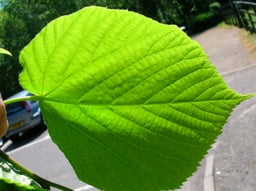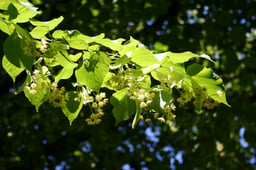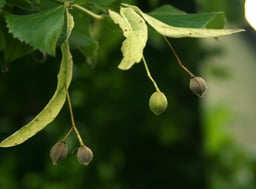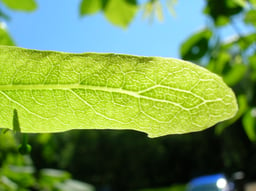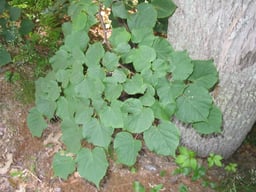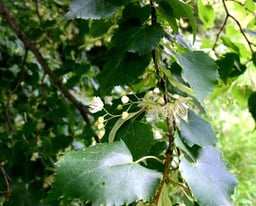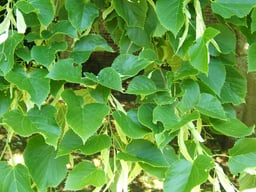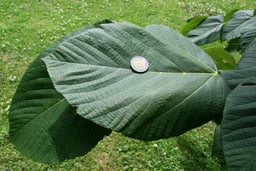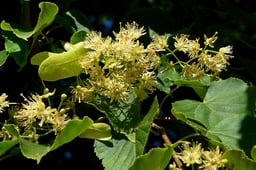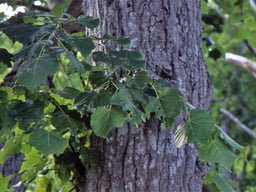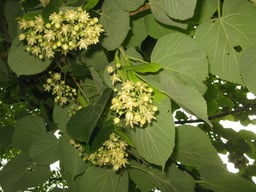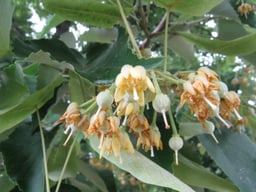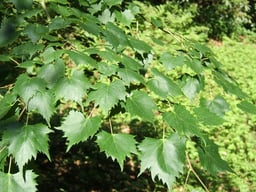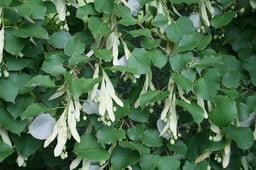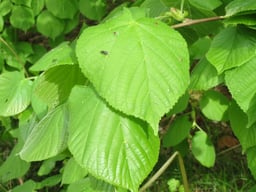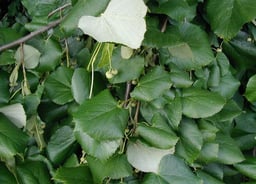Tilia

Tilia

| Tilia | |
|---|---|
| Tilia tomentosa, cultivated at theMorton ArboretumnearChicago | |
| Scientific classification | |
| Kingdom: | Plantae |
| Clade: | Angiosperms |
| Clade: | Eudicots |
| Clade: | Rosids |
| Order: | Malvales |
| Family: | Malvaceae |
| Subfamily: | Tilioideae |
| Genus: | Tilia |
| Species | |
| About 30 | |
Tilia is a genus of about 30 species of trees or bushes, native throughout most of the temperate Northern Hemisphere. In the British Isles, they are commonly called lime trees, or lime bushes, although they are not closely related to the tree that produces the lime fruit. Other names include linden for the European species, and basswood for North American species.[1][2] The genus occurs in Europe and eastern North America, but the greatest species diversity is found in Asia. Under the Cronquist classification system, this genus was placed in the family Tiliaceae, but genetic research summarised by the Angiosperm Phylogeny Group has resulted in the incorporation of this genus, and of most of the previous family, into the Malvaceae.
Tilia species are mostly large, deciduous trees, reaching typically 20 to 40 m (65 to 130 ft) tall, with oblique-cordate leaves 6 to 20 cm (2 1⁄4 to 7 3⁄4 in) across. As with elms, the exact number of species is uncertain, as many of the species can hybridise readily, both in the wild and in cultivation. Limes are hermaphroditic, having perfect flowers with both male and female parts, pollinated by insects.
| Tilia | |
|---|---|
| Tilia tomentosa, cultivated at theMorton ArboretumnearChicago | |
| Scientific classification | |
| Kingdom: | Plantae |
| Clade: | Angiosperms |
| Clade: | Eudicots |
| Clade: | Rosids |
| Order: | Malvales |
| Family: | Malvaceae |
| Subfamily: | Tilioideae |
| Genus: | Tilia |
| Species | |
| About 30 | |
Name
The genus is generally called "lime" or "linden" in Britain[3]*Shorter%20Oxford%20English]]*Shorter%20Oxford%20English]]*Shorter%20Oxford%20English]]*Shorter%20Oxford%20English]]*Shorter%20Oxford%20English]]*Shorter%20Oxford%20English]]*Shorter%20Oxford%20English]]*Shorter%20Oxford%20English]]*Shorter%20Oxford%20English]]*Shorter%20Oxford%20English]]*Shorter%20Oxford%20English]]*Shorter%20Oxford%20English]]*Shorter%20Oxford%20English]]*Shorter%20Oxford%20English]]*Shorter%20Oxford%20English]]*nd "linden", "lime", or "basswood" in North America.
"Lime" is an altered form of Middle English lind, in the 16th century also line, from Old English feminine lind or linde, Proto-Germanic *lendā, cognate to Latin lentus "flexible" and Sanskrit latā "liana". Within Germanic languages, English "lithe", German lind "lenient, yielding" are from the same root.
"Linden" was originally the adjective, "made from linwood or lime-wood" (equivalent to "wooden"); from the late 16th century, "linden" was also used as a noun, probably influenced by translations of German romance, as an adoption of Linden, the plural of German Linde.[5] Neither the name nor the tree is related to the citrus fruit called "lime" (Citrus aurantifolia, family Rutaceae). Another common name used in North America is basswood, derived from bast, the name for the inner bark (see Uses, below). Teil is an old name for the lime tree.
Latin tilia is cognate to Greek πτελέᾱ, ptelea, "elm tree", τιλίαι, tiliai, "black poplar" (Hes.), ultimately from a Proto-Indo-European word *ptel-ei̯ā with a meaning of "broad" (feminine); perhaps "broad-leaved" or similar.[6]
Description
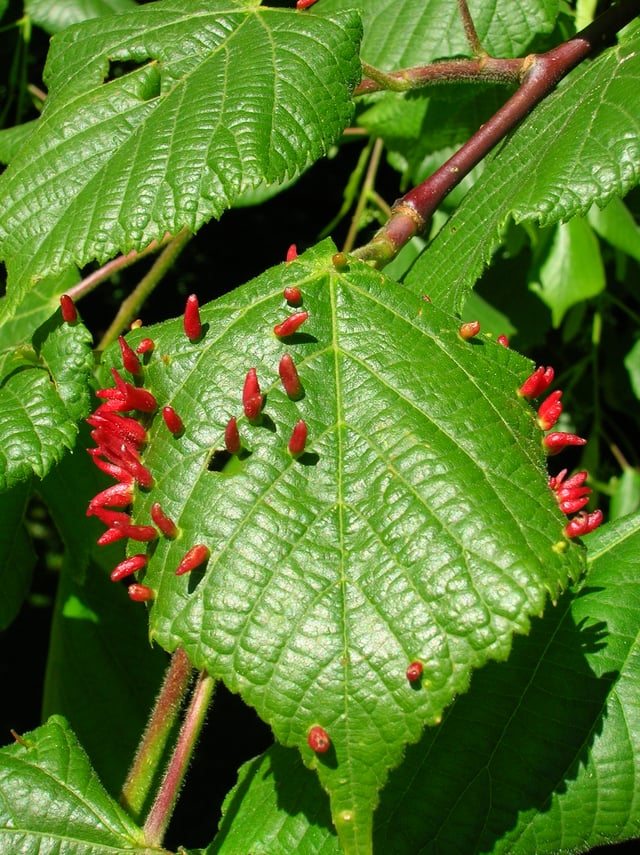
Lime nail galls, caused by the mite Eriophyes tiliae
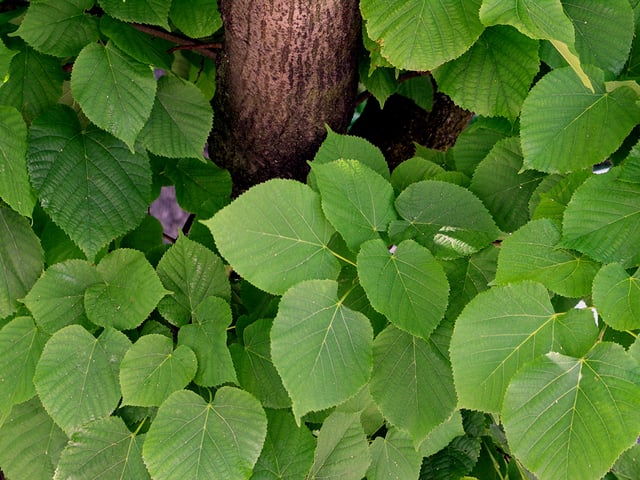
Leaves and trunk
The Tilia's sturdy trunk stands like a pillar and the branches divide and subdivide into numerous ramifications on which the twigs are fine and thick. In summer, these are profusely clothed with large leaves and the result is a dense head of abundant foliage.[7]
The leaves of all the Tilia species are heart-shaped and most are asymmetrical, and the tiny fruit, looking like peas, always hang attached to a ribbon-like, greenish-yellow bract, whose use seems to be to launch the ripened seed clusters just a little beyond the parent tree. The flowers of the European and American Tilia species are similar, except the American ones bear a petal-like scale among their stamens and the European varieties are devoid of these appendages. All of the Tilia species may be propagated by cuttings and grafting, as well as by seed. They grow rapidly in rich soil, but are subject to the attack of many insects. Tilia is notoriously difficult to propagate from seed unless collected fresh in fall. If allowed to dry, the seeds go into a deep dormancy and take 18 months to germinate.[7]
In particular, aphids are attracted by the rich supply of sap, and are in turn often "farmed" by ants for the production of the sap, which the ants collect for their own use, and the result can often be a dripping of excess sap onto the lower branches and leaves, and anything else below.
Cars left under the trees can quickly become coated with a film of the syrup ("honeydew") thus dropped from higher up.
The ant/aphid "farming" process does not appear to cause any serious damage to the trees.
History
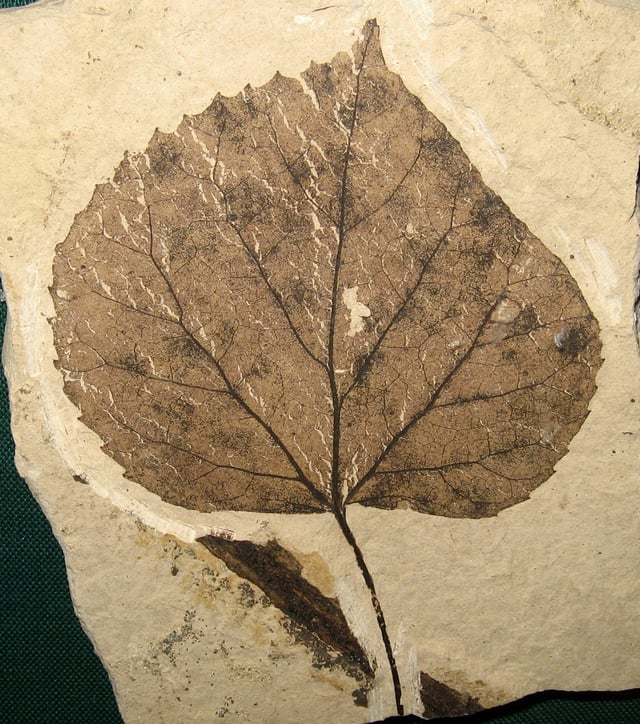
T. johnsoni leaf fossil, 49 Ma, Washington, USA
In Europe, some linden trees reached considerable ages.
A coppice of T. cordata in Westonbirt Arboretum in Gloucestershire is estimated to be 2,000 years old.[8] In the courtyard of the Imperial Castle at Nuremberg is a Tilia, which by tradition recounted in 1900, was planted by the Empress Cunigunde, the wife of Henry II of Germany circa 1000. The Tilia of Neuenstadt am Kocher in Baden-Württemberg, Germany, was estimated at 1000 years old when it fell.[7]Our%20Native%20Trees%20and%20H]]The Alte Linde tree of Naters, Switzerland, is mentioned in a document in 1357 and described by the writer at that time as already ), a 700-year-old* s the thickest tree in Slovenia.[9]
The excellence of the honey of the far-famed Hyblaean Mountains[10] was due to the linden trees that covered its sides and crowned its summit.
Lime fossils have been found in the Tertiary formations of Grinnell Land, Canada, at 82°N latitude, and in Svalbard, Norway. Sapporta believed he had found there the common ancestor of the Tilia species of Europe and America.[7]
Uses

Bombus terrestris on Tilia cordata
The linden is recommended as an ornamental tree when a mass of foliage or a deep shade is desired.[7] The tree produces fragrant and nectar-producing flowers, and the medicinal herb lime blossom. They are very important honey plants for beekeepers, producing a very pale, but richly flavoured monofloral honey. The flowers are also used for herbal teas and tinctures; this kind of use is particularly popular in Europe and also used in North American herbal medicine practices.
Wood

Limewood Saint George by Tilman Riemenschneider, circa 1490
Linden trees produce soft and easily worked timber, which has very little grain and a density of 560 kg/m3.[11] It was often used by Germanic tribes for constructing shields. It is a popular wood for model building and for intricate carving. Especially in Germany, it was the classic wood for sculpture from the Middle Ages onwards and is the material for the elaborate altarpieces of Veit Stoss, Tilman Riemenschneider, and many others. In England, it was the favoured medium of the sculptor Grinling Gibbons[12] (1648–1721). The wood is used in marionette- and puppet-making and -carving. Having a fine, light grain and being comparatively light in weight, it has been used for centuries for this purpose; despite the availability of modern alternatives, it remains one of the main materials used as of 2015.
Ease of working and good acoustic properties also make limewood popular for electric guitar and bass bodies and for wind instruments such as recorders. Percussion manufacturers sometimes use Tilia as a material for drum shells, both to enhance their sound and for their aesthetics.
The aquarium industry uses limewood as an air diffuser inside protein skimmers. Air pumped through the grain of the wood turns into consistently very fine bubbles (0.5–1.0 mm), difficult to achieve with any other natural or man-made medium. However, the wood decomposes underwater much faster than ceramic air stones and must be replaced more frequently for maximum efficiency.
Limewood is also the material of choice for window blinds and shutters.
Real-wood blinds are often made from this lightweight but strong and stable wood, which is well suited to natural and stained finishes.
Bark
Known in the trade as basswood, particularly in North America, its name originates from the inner fibrous bark of the tree, known as bast.
A strong[13] fibre]]is obtained from the tree by peeling off the bark and soaking it in water for a month, after which the inner fibres can be easily separated. Bast obtained from the inside of the bark of the been used by the Ainu people of Japan to weave their traditional clothing, the attus. Recent excavations in Britain [22] have shown that "lime tree fibre" was preferred for clothing there during the Bronze Age. Similar fibres obtained from other plants are also called bast: see Bast fibre.
Herbalism
The dried flowers are mildly sweet and sticky, and the fruit is somewhat sweet and mucilaginous.
Limeflower tea has a pleasing taste, due to the aromatic volatile oil found in the flowers.
The flowers, leaves, wood, and charcoal (obtained from the wood) are used for medicinal purposes.
Active ingredients in the Tilia flowers include flavonoids (which act as antioxidants) and volatile oils. The plant also contains tannins that can act as an astringent.[14]
Linden flowers are used in herbalism for colds, cough, fever, infections, inflammation, high blood pressure, and headache (particularly migraine), and as a diuretic (increases urine production), antispasmodic (reduces smooth muscle spasm along the digestive tract), and sedative.[15] In the traditional Austrian medicine, Tiliaspp. flowers have been used internally as tea for treatment of disorders of the respiratory tract, fever, and flu.[16] New evidence shows that the flowers may be hepatoprotective.[17] The wood is used for liver and gallbladder disorders and cellulitis (inflammation of the skin and surrounding soft tissue). That wood burned to charcoal is ingested to treat intestinal disorders and used topically to treat edema or infection such as cellulitis or ulcers of the lower leg.[14]
Classification
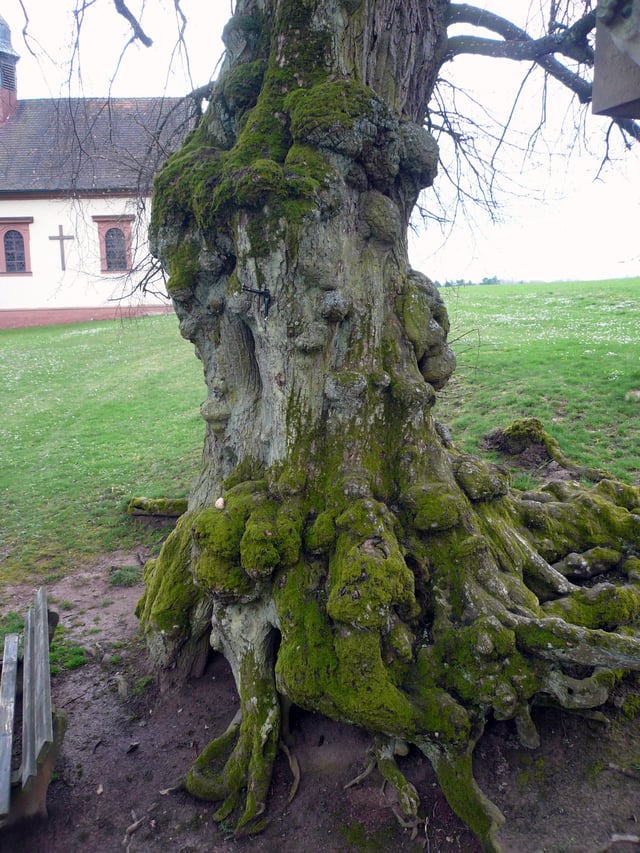
Bole of an ancient Tilia at Frankenbrunn, Bavaria

Ancient lime tree at Chilston Park, England

Avenue of lime trees at Turville Heath

A 15-year-old lime-tree, Haute-Savoie, France

Tilia in the Münzenberg Castle
This list comprises the most widely accepted species, hybrids, and cultivars".
Species
Tilia americana L. – American basswood, American linden
Tilia amurensis – Amur lime, Amur linden
Tilia caroliniana
Tilia chinensis
Tilia chingiana Hu & W.C.Cheng
Tilia cordata Mill. – Small-leaved lime, little-leaf linden or greenspire linden
Tilia dasystyla
Tilia henryana Szyszyl. – Henry's lime, Henry's linden
Tilia hupehensis – Hubei lime
Tilia insularis
Tilia intonsa
Tilia japonica – Japanese lime, shina (when used as a laminate)
†Tilia johnsoni Wolfe & Wehr Eocene; Washington and British Columbia
Tilia kiusiana
Tilia mandshurica – Manchurian lime
Tilia maximowicziana
Tilia miqueliana
Tilia mongolica
Tilia nasczokinii
Tilia nobilis
Tilia oliveri – Oliver's lime
Tilia paucicostata
Tilia platyphyllos Scop. – large-leaved lime
Tilia rubra – Red stem lime (syn. T. platyphyllos var. rubra)
Tilia tomentosa Moench – silver lime, silver linden
Tilia tuan Szyszyl.
Hybrids and cultivars
Tilia × euchlora (T. dasystyla × T. cordata)
Tilia × europaea – Common lime (T. cordata × T. platyphyllos; syn. T. × vulgaris)
Tilia × petiolaris (T. tomentosa × T. ?)
Tilia 'Flavescens' – Glenleven linden (T. americana × T. cordata)
Tilia 'Moltkei' (T. americana × T. petiolaris)
Tilia 'Orbicularis' (hybrid, unknown origin)
Tilia 'Spectabilis' (hybrid, unknown origin)
